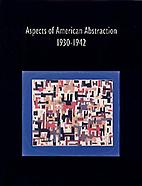Artists included in this exhibition: Benjamin Benno, Emil Bisttram, Ilya Bolotowsky, Byron Browne, Giorgio Cavallon, Burgoyne Diller, Arthur Dove, Werner Drewes, John Ferren, A. E. Gallatin, Ed Garman, Dwinnell Grant, Hananiah Harari, Charles Howard, Raymond Jonson, Paul Kelpe, Joseph Meierhans, George L. K. Morris, Irene Rice Pereira, Ralph Rosenborg, Theodore Roszak, Louis Schanker, Charles Shaw, Esphyr Slobodkina, John Von Wicht, Vaclav Vytlacil, and Jean Xceron
Aspects of American Abstraction, 1930-1942
February 11 – March 27, 1993
Artists
-
- Emil Bisttram (1895-1976)
- Ilya Bolotowsky (1907-1981)
- Werner Drewes (1899 — 1985)
- John Ferren (1905-1970)
- Albert E. Gallatin (1881-1952)
- Ed Garman (1914-2004)
- Charles Howard (1899-1978)
- Raymond Jonson (1891-1982)
- Paul Kelpe (1902-1985)
- Irene Rice Pereira (1902-1971)
- Theodore Roszak (1907-1981)
- Jean Xceron (1890-1967)
Publications
Press Release
Aspects of American Abstraction: 1930 - 1942 explores the emergence of abstract art in America during the Great Depression and WWII. Included in the exhibition are members of the American Abstract Artists organization founded in New York, the Transcendental Painting Group, which was centered in the Southwest, and other artists who were working independently.
During the 1930s, American Abstract Artists drew their visual and ideological vocabulary primarily from European modernism. Many of the artists either travelled to or emigrated from Europe. Cubism, Constructivism, Neo-plasticism, and Surrealism are all reflected in the art, resulting in a variety of dynamic abstract styles.

